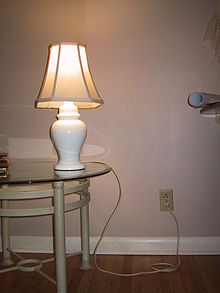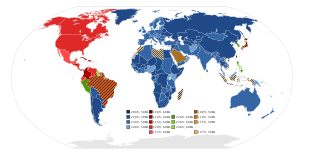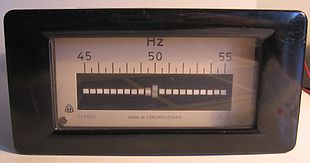- Mains electricity
-
Mains is the general-purpose alternating current (AC) electric power supply. In the US, electric power is referred to by several names including household power, household electricity, powerline, domestic power, wall power, line power, AC power, city power, street power, and grid power. In many parts of Canada, it is called hydro, because much of the Canadian electrical generating capacity is hydroelectric.
Contents
Mains power systems
For a list of voltages, frequencies, and wall plugs by country, see Mains electricity by country
Worldwide, many different mains power systems are found for the operation of household and light commercial electrical appliances and lighting. The different systems are primarily characterized by their
but also by their
- Earthing system (grounding)
- Protection against overcurrent damage (e.g., due to short circuit), electric shock, and fire hazards
- Parameter tolerances
All these parameters vary among regions. The voltages are generally in the range 100–240 V (always expressed as root-mean-square voltage). The two commonly used frequencies are 50 Hz and 60 Hz.
Some territories use standards different from those of the countries they belong to (such as Hong Kong in China, similar voltage but different AC power plugs and sockets). Foreign enclaves, such as large industrial plants or overseas military bases, may have a different standard voltage and frequency from the surrounding areas. Some city areas may use standards different from that of the surrounding countryside (e.g. in Libya). Regions in an effective state of anarchy may have no central electrical authority, with electric power provided by incompatible private sources.
Many other combinations of voltage and utility frequency, including direct current, were formerly used, with frequencies between 25 Hz and 133 Hz and voltages from 100 to 250 V. The modern standard combinations of 230 V/50 Hz and 120 V/60 Hz did not apply in the first few decades of the 20th century and are still not universal.
Industrial plants with polyphase power systems will have different, higher voltages installed for large equipment (and different sockets and plugs), but the common voltages listed here would still be found for lighting and portable equipment.
Building wiring
In most countries, household power is single-phase electric power, with two or three wired contacts at each outlet.
- The live wire (also known as phase, hot or active contact), carries alternating current between the power grid and the household.
- The neutral wire completes the electrical circuit by also carrying alternating current between the power grid and the household. The neutral is staked into the ground as often as possible, and therefore has the same electrical potential as the earth. This prevents the power circuits from rising beyond earth, such as when they are struck by lightning or become otherwise charged.
- The earth wire or ground connects cases of equipment to earth ground as a protection against faults (Electric Shock).
For more details on this topic, see Ground and neutral.Various earthing systems are used to ensure that the ground and neutral wires have the correct voltages, to prevent shocks when touching grounded objects.
In some installations, there may be two live conductors which carry alternating currents in a three wire single-phase circuit.
Small portable electrical equipment is connected to the power supply through flexible cables terminated in a plug, which is then inserted into a fixed receptacle (socket). Larger household electrical equipment and industrial equipment may be permanently wired to the fixed wiring of the building. For example, in North American homes a window-mounted self-contained air conditioner unit would be connected to a wall plug, whereas the central air conditioning for a whole home would be permanently wired. Larger plug and socket combinations are used for industrial equipment carrying larger currents, higher voltages, or three phase electric power.
Circuit breakers and fuses are used to detect short circuits between the live and neutral wires, or the drawing of more current than the wires are rated to handle to prevent overheating and fire. These protective devices are usually mounted in a central panel in a building, but some wiring systems also provide an over current protection device at the socket or within the plug.
Residual-current devices, also known as ground-fault circuit interrupters and appliance leakage current interrupters, are used to detect ground faults - leakage of current to somewhere other than the neutral and live wires (like the ground wire or a person). When a ground fault is detected, the device quickly cuts off the circuit.
Voltage levels
All of Europe, Africa, Asia, Australia, New Zealand and most of South America use a supply that is within 6% of 230 V, whereas Japan, Taiwan, North America and some parts of northern South America use a voltage between 100 and 127 V. The 230 V standard has become the most widespread so standard 230 V equipment can be used in most parts of the world with the aid of an adapter or a change to the equipment's connection plug for the specific country.
Measuring voltage
A distinction should be made between the voltage at the point of supply (nominal system voltage) and the voltage rating of the equipment (utilization voltage). Typically the utilization voltage is 3% to 5% lower than the nominal system voltage; for example, a nominal 208 V supply system will be connected to motors with "200 V" on their nameplates. This allows for the voltage drop between equipment and supply. Voltages in this article are the nominal supply voltages and equipment used on these systems will carry slightly lower nameplate voltages.
Power distribution system voltage is nearly sinusoidal in nature. Voltages are expressed as root mean square (RMS) voltage. Voltage tolerances are for steady-state operation. Momentary heavy loads, or switching operations in the power distribution network, may cause short-term deviations out of the tolerance band. In general, power supplies derived from large networks with many sources are more stable than those supplied to an isolated community with perhaps only a single generator.
Choice of voltage
The choice of utilization voltage is due more to historical reasons than optimization of the distribution system—once a voltage is in use and equipment using this voltage is widespread, changing voltage is a drastic and expensive measure. A 230 V distribution system will use less conductor material to deliver a given amount of power because the current, and consequently the resistive loss, is lower than for a 120 V system. While large heating appliances can use smaller conductors at 230 V for the same output rating, few household appliances use anything like the full capacity of the outlet to which they are connected. Minimum wire size for hand-held or portable equipment is usually restricted by the mechanical strength of the conductors. Electrical appliances are used extensively in homes in both 230 V and 120 V system countries. National electrical codes prescribe wiring methods intended to minimize the risk of electric shock and fire.
Many areas using (nominally) 120 V make use of three-wire, single-phase 240 V systems to supply large appliances. Three-phase systems can be connected to give various combinations of voltage, suitable for use by different classes of equipment. Where both single-phase and three-phase loads are served by an electrical system, the system may be labelled with both voltages such as 120/208 or 230/400 V, to show the line-to-neutral voltage and the line-to-line voltage. Large loads are connected for the higher voltage. Other three-phase voltages, up to 830 volts, are occasionally used for special-purpose systems such as oil well pumps.
Large industrial motors (say, more than 250 HP or 150 kW) may operate on medium voltage. On 60 Hz systems a standard for medium voltage equipment is 2300/4160 V whereas 3300 V is the common standard for 50 Hz systems.
Standardization
Following voltage harmonization, electricity supplies within the European Union are now nominally 230 V ± 6% at 50 Hz.[1] For a transition period (1995–2008), countries that had previously used 220 V changed to a narrower asymmetric tolerance range of 230 V +6% −10% and those (like the UK) that had previously used 240 V changed to 230 V +10% −6%.[2] No change in voltage is required by either system as both 220 V and 240 V fall within the lower 230 V tolerance bands (230 V ±6%). In practice, this allows countries to continue to supply the same voltage (220 or 240 V), at least until existing supply transformers are replaced. Equipment used in these countries is designed to accept any voltage within the specified range.
In the United States[3] and Canada,[4] national standards specify that the nominal voltage at the source should be 120 V and allow a range of 114 to 126 V (−5% to +5%). Historically 110, 115 and 117 volts have been used at different times and places in North America. Main power is sometimes spoken of as 110; however, 120 is the nominal voltage.
In 2000, Australia converted to 230 V as the nominal standard with a tolerance of +10% −6%.,[5] this superseding the old 240 V standard, AS2926-1987.[6] As in the UK, 240 V is within the allowable limits and "240 volt" is a synonym for mains in Australian and British English.
In Japan, the electrical power supply to households is at 100 V. Eastern and northern parts of Honshū (including Tokyo) and Hokkaidō have a frequency of 50 Hz, whereas western Honshū (including Nagoya, Osaka, and Hiroshima), Shikoku, Kyūshū and Okinawa operate at 60 Hz. The boundary between the two regions contains four back-to-back HVDC substations which convert the frequency; these are Shin Shinano, Sakuma Dam, Minami-Fukumitsu, and the Higashi-Shimuzu Frequency Converter. To accommodate the difference, frequency-sensitive appliances marketed in Japan can often be switched between the two frequencies.
History of voltage and frequency
The system of three-phase alternating current electrical generation, transmission, and distribution was developed in the 19th century by Nikola Tesla, George Westinghouse and others. Thomas Edison developed direct current (DC) systems at 110 V and this was claimed to be safer in the battles between proponents of AC and DC supply systems (the War of Currents). Edison chose 110 volts to make high-resistance carbon filament lamps both practical and economically competitive with gas lighting. While higher voltages would reduce the current required for a given quantity of lamps, the filaments would become increasingly fragile and short-lived. Edison selected 100 volts for the lamp as a compromise between distribution costs and lamp costs. Generation was maintained at 110 volts to allow for a voltage drop between generator and lamp.
In the 1880s only carbon-filament incandescent lamps were available, designed for a voltage of around 100 volts. Later metal filament lamps became feasible. In 1899, the Berliner Elektrizitäts-Werke (BEW), a Berlin electrical utility, decided to greatly increase its distribution capacity by switching to 220 volt nominal distribution, taking advantage of the higher voltage capability of metal filament lamps. The company was able to offset the cost of converting the customer's equipment by the resulting saving in distribution conductors cost. This became the model for electrical distribution in Germany and the rest of Europe and the 220-volt system became common. North American practice remained with voltages near 110 volts for lamps.[7]
In 1883 Edison patented a three wire distribution system to allow DC generation plants to serve a wider radius of customers. This saved on copper costs since lamps were connected in series on a 220 volt system, with a neutral conductor connected between to carry any unbalance between the two sub-circuits. This was later adapted to AC circuits. Most lighting and small appliances ran on 120 V, while big appliances could be connected to 240 V. This system saved copper and was backward-compatible with existing appliances. Also, the original plugs could be used with the revised system.
Main article: Utility frequencyAt the end of the 19th century, Westinghouse in the US decided on 60 Hz and AEG in Germany decided on 50 Hz, eventually leading to the world being mostly divided into two frequency camps. Most 60 Hz systems are nominally 120 volts and most 50 Hz nominally 230 volts.
Voltage regulation
To maintain the voltage at the customer's service within the acceptable range, electrical distribution utilities use regulating equipment at electrical substations or along the distribution line. At a substation, the step-down transformer will have an automatic on-load tap changer, allowing the ratio between transmission voltage and distribution voltage to be adjusted in steps. For long (several kilometers) rural distribution circuits, automatic voltage regulators may be mounted on poles of the distribution line. These are autotransformers again with on-load tapchangers to adjust the ratio depending on the observed voltage changes.
At each customer's service, the step-down transformer has up to five taps to allow some range of adjustment, usually ±5% of the nominal voltage. Since these taps are not automatically controlled, they are only used to adjust the long-term average voltage at the service and do not regulate the voltage seen by the utility customer.
See also
- Domestic AC power plugs and sockets
- Electricity
- Energy meter
- Mains electricity by country
- Potential difference
- Power connector
- Three-phase electric power
- Meter Point Administration Number
References
- ^ CENELEC Harmonization Document HD 472 S1:1988
- ^ British Standard BS 7697: Nominal voltages for low voltage public electricity supply systems — (Implementation of HD 472 S1)
- ^ ANSI C84.1: American National Standard for Electric Power Systems and Equipment—Voltage Ratings (60 Hertz)
- ^ CSA C3-235: Preferred Voltage Levels for AC Systems, 0 to 50 000 V
- ^ AS60038-2000 Standards Australia - Standard Voltages
- ^ SAI Global
- ^ Thomas P. Hughes, Networks of Power: Electrification in Western Society 1880-1930, The Johns Hopkins University Press,Baltimore 1983 ISBN 0-8018-2873-2 pg. 193
External links
Categories:
Wikimedia Foundation. 2010.



